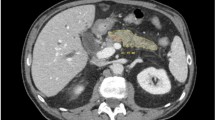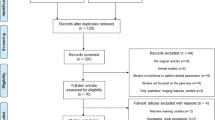Abstract
Purpose
The purpose of this study is to evaluate diagnostic performance of a commercially available radiomics research prototype vs. an in-house radiomics software in the binary classification of CT images from patients with pancreatic ductal adenocarcinoma (PDAC) vs. healthy controls.
Materials and methods
In this retrospective case–control study, 190 patients with PDAC (97 men, 93 women; 66 ± 9 years) from 2012 to 2017 and 190 healthy potential renal donors (96 men, 94 women; 52 ± 8 years) without known pancreatic disease from 2005 to 2009 were identified from radiology and pathology databases. 3D volume of the pancreas was manually segmented from preoperative CT scans. Four hundred and seventy-eight radiomics features were extracted using in-house radiomics software. Eight hundred and fifty-four radiomics features were extracted using a commercially available research prototype. Random forest classifier was used for binary classification of PDAC vs. normal pancreas. Accuracy, sensitivity, and specificity of commercially available radiomics software were compared to in-house software.
Results
When 40 radiomics features were used in the random forest classification, in-house software achieved superior sensitivity (1.00) and accuracy (0.992) compared to the commercially available research prototype (sensitivity = 0.950, accuracy = 0.968). When the number of features was reduced to five features, diagnostic performance of the in-house software decreased to sensitivity (0.950), specificity (0.923), and accuracy (0.936). Diagnostic performance of the commercially available research prototype was unchanged.
Conclusion
Commercially available and in-house radiomics software achieve similar diagnostic performance, which may lower the barrier of entry for radiomics research and allow more clinician-scientists to perform radiomics research.




Similar content being viewed by others
References
Gillies RJ, Kinahan PE, Hricak H (2016) Radiomics: Images Are More than Pictures, They Are Data. Radiology 278 (2):563–577. https://doi.org/10.1148/radiol.2015151169
Bluemke DA (2020) Top Publications in Radiology, 2019. Radiology 294 (1):2–3. https://doi.org/10.1148/radiol.2019194017
Carlos RC, Kahn CE, Halabi S (2018) Data Science: Big Data, Machine Learning, and Artificial Intelligence. J Am Coll Radiol 15 (3 Pt B):497–498. https://doi.org/10.1016/j.jacr.2018.01.029
Lubner MG, Smith AD, Sandrasegaran K, Sahani DV, Pickhardt PJ (2017) CT Texture Analysis: Definitions, Applications, Biologic Correlates, and Challenges. Radiographics : a review publication of the Radiological Society of North America, Inc 37 (5):1483–1503. https://doi.org/10.1148/rg.2017170056
Bodalal Z, Trebeschi S, Nguyen-Kim TDL, Schats W, Beets-Tan R (2019) Radiogenomics: bridging imaging and genomics. Abdominal radiology 44 (6):1960–1984. https://doi.org/10.1007/s00261-019-02028-w
Chu LC, Park S, Kawamoto S, Fouladi DF, Shayesteh S, Zinreich ES, Graves JS, Horton KM, Hruban RH, Yuille AL, Kinzler KW, Vogelstein B, Fishman EK (2019) Utility of CT Radiomics Features in Differentiation of Pancreatic Ductal Adenocarcinoma From Normal Pancreatic Tissue. AJR American journal of roentgenology:1–9. https://doi.org/10.2214/ajr.18.20901
Kumar V, Gu Y, Basu S, Berglund A, Eschrich SA, Schabath MB, Forster K, Aerts HJ, Dekker A, Fenstermacher D, Goldgof DB, Hall LO, Lambin P, Balagurunathan Y, Gatenby RA, Gillies RJ (2012) Radiomics: the process and the challenges. Magnetic resonance imaging 30 (9):1234–1248. https://doi.org/10.1016/j.mri.2012.06.010
Kocak B, Durmaz ES, Erdim C, Ates E, Kaya OK, Kilickesmez O (2019) Radiomics of Renal Masses: Systematic Review of Reproducibility and Validation Strategies. AJR American journal of roentgenology:1–8. https://doi.org/10.2214/ajr.19.21709
Meyer M, Ronald J, Vernuccio F, Nelson RC, Ramirez-Giraldo JC, Solomon J, Patel BN, Samei E, Marin D (2019) Reproducibility of CT Radiomic Features within the Same Patient: Influence of Radiation Dose and CT Reconstruction Settings. Radiology 293 (3):583–591. https://doi.org/10.1148/radiol.2019190928
Yamashita R, Perrin T, Chakraborty J, Chou JF, Horvat N, Koszalka MA, Midya A, Gonen M, Allen P, Jarnagin WR, Simpson AL, Do RKG (2020) Radiomic feature reproducibility in contrast-enhanced CT of the pancreas is affected by variabilities in scan parameters and manual segmentation. European radiology 30 (1):195–205. https://doi.org/10.1007/s00330-019-06381-8
Kim H, Park CM, Gwak J, Hwang EJ, Lee SY, Jung J, Hong H, Goo JM (2019) Effect of CT Reconstruction Algorithm on the Diagnostic Performance of Radiomics Models: A Task-Based Approach for Pulmonary Subsolid Nodules. AJR American journal of roentgenology 212 (3):505–512. https://doi.org/10.2214/ajr.18.20018
Foy JJ, Robinson KR, Li H, Giger ML, Al-Hallaq H, Armato SG (2018) Variation in algorithm implementation across radiomics software. J Med Imaging (Bellingham) 5 (4):044505. https://doi.org/10.1117/1.jmi.5.4.044505
Orlhac F, Frouin F, Nioche C, Ayache N, Buvat I (2019) Validation of A Method to Compensate Multicenter Effects Affecting CT Radiomics. Radiology 291 (1):53–59. https://doi.org/10.1148/radiol.2019182023
Park S, Lee SM, Do KH, Lee JG, Bae W, Park H, Jung KH, Seo JB (2019) Deep Learning Algorithm for Reducing CT Slice Thickness: Effect on Reproducibility of Radiomic Features in Lung Cancer. Korean journal of radiology : official journal of the Korean Radiological Society 20 (10):1431–1440. https://doi.org/10.3348/kjr.2019.0212
Zhovannik I, Bussink J, Traverso A, Shi Z, Kalendralis P, Wee L, Dekker A, Fijten R, Monshouwer R (2019) Learning from scanners: Bias reduction and feature correction in radiomics. Clin Transl Radiat Oncol 19:33–38. https://doi.org/10.1016/j.ctro.2019.07.003
Choe J, Lee SM, Do KH, Lee G, Lee JG, Seo JB (2019) Deep Learning-based Image Conversion of CT Reconstruction Kernels Improves Radiomics Reproducibility for Pulmonary Nodules or Masses. Radiology 292 (2):365–373. https://doi.org/10.1148/radiol.2019181960
Aerts HJ, Velazquez ER, Leijenaar RT, Parmar C, Grossmann P, Carvalho S, Bussink J, Monshouwer R, Haibe-Kains B, Rietveld D, Hoebers F, Rietbergen MM, Leemans CR, Dekker A, Quackenbush J, Gillies RJ, Lambin P (2014) Decoding tumour phenotype by noninvasive imaging using a quantitative radiomics approach. Nature communications 5:4006. https://doi.org/10.1038/ncomms5006
Funding
Linda C. Chu, Seyoun Park, Satomi Kawamoto, Alan L. Yuille, and Elliot K. Fishman received research support from the Lustgarten Foundation. Linda C. Chu, Seyoun Park, and Elliot K. Fishman received additional research support from the Emerson Collective. Other authors have no disclosures.
Author information
Authors and Affiliations
Corresponding author
Ethics declarations
Conflict of interest
The authors declare no conflicts of interest.
Ethics approval
This was an IRB-approved retrospective study.
Informed consent
Patient consent was waived given retrospective nature of the study.
Additional information
Publisher's Note
Springer Nature remains neutral with regard to jurisdictional claims in published maps and institutional affiliations.
Rights and permissions
About this article
Cite this article
Chu, L.C., Solmaz, B., Park, S. et al. Diagnostic performance of commercially available vs. in-house radiomics software in classification of CT images from patients with pancreatic ductal adenocarcinoma vs. healthy controls. Abdom Radiol 45, 2469–2475 (2020). https://doi.org/10.1007/s00261-020-02556-w
Published:
Issue Date:
DOI: https://doi.org/10.1007/s00261-020-02556-w




